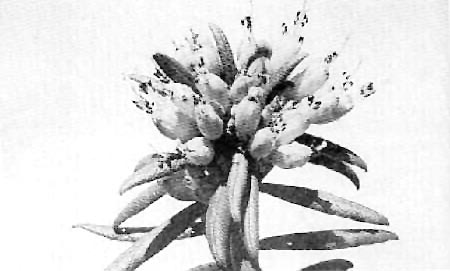Rhododendron spinuliferum
By P. H. Brydon

|
|
Rhododendron spinuliferum
Photo by P. H. Brydon |
Rhododendron spinuliferum
is included in the Scabrifolium Series and is found growing in shady thickets at altitudes of from 6000 to 8000 ft. in the Province of Yunnan in S. W. China. As can be seen by the accompanying illustration, the flowers are quite unusual in that the corolla is tubular and contracted at the end with the stamens and pistils prominently exserted. The blossoms appear in late April and early May and are produced in the axils of the terminal leaves. Each flower is fully one inch long and a striking brick red color which fades to a lighter shade towards the tips of the petals. The plants attain a height of 8 feet and, if allowed to grow unchecked, become rather leggy shrubs. They require protection from strong winds but will not tolerate too much shade otherwise the plants become leggy and few flowers are produced from the willowy branches.
R. spinuliferum
is an excellent subject for the shrub border where it makes an admirable companion for the white and yellow species of the Triflorum Series. It is easily grown from either seed or cuttings and, if propagated from seed, can be made to flower in four or five years. The young plants should be pinched back to induce branching from the base. These primary branches should again be pinched so that a well formed bushy plant results.
This species has been successfully used as a parent when crossed with its near relatives in the Triflorum, Maddenii, Virgatum, and Moupinense Series. Its progeny include such charming hybrids as R. 'Crossbill' (
spinuliferum
x
lutescens
). R. 'Seta', A. M. (
spinuliferum
x
moupinense
) and R. 'Spinulosum' (
spinuliferum
x
racemosum
).
R. spinuliferum
is an outstanding example of the extreme variations to be found in this great genus and offers interesting possibilities to the hybridist in his search for new parental types. From the writer's experience with this species on the Pacific Coast. it certainly deserves the three stars accorded by the Rhododendron Association of Great Britain and is a desirable ornamental for any garden where rhododendrons can be grown.